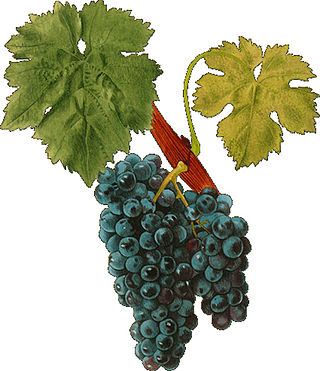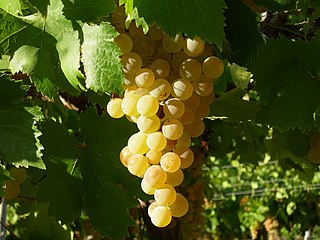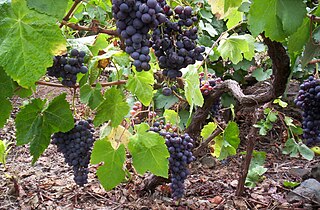Related Research Articles

Merlot is a dark blue–colored wine grape variety that is used as both a blending grape and for varietal wines. The name Merlot is thought to be a diminutive of merle, the French name for the blackbird, probably a reference to the color of the grape. Its softness and "fleshiness," combined with its earlier ripening, make Merlot a popular grape for blending with the sterner, later-ripening Cabernet Sauvignon, which tends to be higher in tannin.

Syrah, also known as Shiraz, is a dark-skinned grape variety grown throughout the world and used primarily to produce red wine. In 1999, Syrah was found to be the offspring of two obscure grapes from southeastern France, Dureza and Mondeuse Blanche. Syrah should not be confused with Petite Sirah, a cross of Syrah with Peloursin dating from 1880.

Cabernet Franc is one of the major black grape varieties worldwide. It is principally grown for blending with Cabernet Sauvignon and Merlot in the Bordeaux style, but can also be vinified alone, as in the Loire's Chinon. In addition to being used in blends and produced as a varietal in Canada and the United States, it is sometimes made into ice wine in those regions.

Malbec is a purple grape variety used in making red wine. The grapes tend to have an inky dark color and robust tannins, and are known as one of the six grapes allowed in the blend of red Bordeaux wine. In France, plantations of Malbec are now found primarily in Cahors in South West France, though the grape is grown worldwide. It is also available as an Argentine varietal.

Carignan is a red grape variety of Spanish origin that is more commonly found in French wine but is widely planted throughout the western Mediterranean and around the globe. Along with Aramon, it was considered one of the main grapes responsible for France's wine lake and was a substantial producer in jug wine production in California's Central Valley but in recent years, it has been reborn as a flagship wine for many cellars in the south of France as well as in Catalonia.

Chile has a long history in the production of wine, with roots dating back to the 16th century when the Spanish conquistadors introduced Vitis vinifera vines to the region. In the mid-19th century, French wine varieties such as Cabernet Sauvignon, Merlot, Carmenère, and Franc were introduced. During the early 1980s, the Chilean wine industry underwent a renaissance with the introduction of stainless steel fermentation tanks and the use of oak barrels for aging. This led to a rapid growth in exports as quality wine production increased. The number of wineries in Chile rose from 12 in 1995 to over 70 in 2005.

Grenache or Garnacha is one of the most widely planted red wine grape varieties in the world. It ripens late, so it needs hot, dry conditions such as those found in Spain, where the grape is believed to have originated. It is also grown in the Italian island of Sardinia, the south of France, Australia, and California's Monterey AVA, Paso Robles, Santa Barbara County and San Joaquin Valley.

Tempranillo is a black grape variety widely grown to make full-bodied red wines in its native Spain. Its name is the diminutive of the Spanish temprano ("early"), a reference to the fact that it ripens several weeks earlier than most Spanish red grapes. Tempranillo has been grown on the Iberian Peninsula since the time of Phoenician settlements. It is the main grape used in Rioja, and is often referred to as Spain's noble grape. The grape has been planted throughout the globe's wine regions.

New World wines are those wines produced outside the traditional winegrowing areas of Europe and the Middle East, in particular from Argentina, Australia, Canada, Chile, Mexico, New Zealand, South Africa and the United States. The phrase connotes a distinction between these "New World" wines and those wines produced in "Old World" countries with a long-established history of wine production, essentially in Europe, most notably: France, Italy, Germany, Spain and Portugal.

Pedro Ximénez is the name of a white Spanish wine grape variety grown in several Spanish wine regions but most notably in the denominación de origen (DO) of Montilla-Moriles. Here it is used to produce a varietal wine, an intensely sweet, dark, dessert sherry. It is made by drying the grapes under the hot sun, concentrating the sweetness, which are then used to create a thick, black liquid with a strong taste of raisins and molasses that is fortified and aged in solera.

Argentina is the fifth largest producer of wine in the world. Argentine wine, as with some aspects of Argentine cuisine, has its roots in Spain. During the Spanish colonization of the Americas, vine cuttings were brought to Santiago del Estero in 1557, and the cultivation of the grape and wine production stretched first to neighboring regions, and then to other parts of the country.

Torrontés is a white grape variety, mostly produced and known in Argentina, producing fresh, aromatic wines with moderate acidity, smooth texture and mouthfeel as well as distinctive peach and apricot aromas on the nose. Three Torrontés varieties exist in Argentina: Torrontés Riojano, the most common, Torrontés Sanjuanino, and Torrontés Mendocino. It is primarily Torrontés Riojano that has received attention for the quality of its wines, and is the variety used for most Argentine wines simply labeled Torrontés.

Pais is a red wine grape that has played a prominent role in the Chilean wine industry. Up until the turn of the 21st century, it was Chile's most planted variety until it was overtaken by Cabernet Sauvignon. Today it is most commonly used in the production of jug wine in the Bío-Bío, Maule and Itata River regions in the south. The grape is sometimes known as Negra Peruana. In Argentina the grape is known as Criolla Chica.
Cereza is a white Argentine wine grape variety. Like Gewürztraminer and Pinot gris, Cereza is a pink skinned variety. It is a crossing of Muscat of Alexandria and Listan negro.
Dimyat is a white Bulgarian wine grape. It is one of Bulgaria's most widely planted white grape varieties, second only to Rkatsiteli. Wines made from this variety are noted for their perfume aromas. While some ampelographers believe that the variety is indigenous to Bulgaria, legends have developed around Dimiat being named after a city in the Nile Delta and was brought back to Europe by Crusaders in the Middle Ages.

Mendoza Province is Argentina's most important wine region, accounting for nearly two-thirds of the country's entire wine production. Located in the eastern foothills of the Andes, in the shadow of Aconcagua, vineyards are planted at some of the highest altitudes in the world, with the average site located 600–1,100 metres (2,000–3,600 ft) above sea level. The principal wine producing areas fall into two main departments-Maipú and Luján, which includes Argentina's first delineated appellation established in 1993 in Luján de Cuyo. The pink-skinned grapes of Criolla Grande and Cereza account for more than a quarter of all plantings but Malbec is the region's most important planting, followed closely by Cabernet Sauvignon, Tempranillo and Chardonnay. Mendoza is considered the heart of the winemaking industry in Argentina with the vast majority of large wineries located in the provincial capital of Mendoza.

Pedro Giménez is a white Argentine wine grape that is rapidly declining in plantings. Despite the similar name, the Spanish wine grape Pedro Ximénez is a different variety with ampelographers are not yet certain if the two grapes are in any way related. Grown predominantly in the Mendoza wine region, Pedro Giménez makes simple wines similar to those made from Cereza and Criolla Grande. It is also grown in Bolivia, where it is made into single varietal wine at the Uvairenda winery in Samaipata. There are some plantings in Chile where it is a minor grape in pisco production.

Listán Negro is a red Spanish wine grape variety that is widely planted in the Canary Islands, particularly on the island of Tenerife where it is a permitted variety in the Denominaciones de Origen (DO) wines of Tacoronte-Acentejo, Valle de la Orotava, Ycoden-Daute-Isora, and Valle de Güímar. It is also permitted in the Spanish wine regions of El Hierro, Gran Canaria, La Gomera, La Palma, Lanzarote. More than 5,000 hectares of the Listán Negro grape variety are planted across the Canary Islands.
Listán Prieto is a red grape variety that is believed to be originated from the Castilla-La Mancha region in Spain. Listán Prieto has disappeared from Spain mainland, but there are still 29 ha planted on the Canary Islands in 2008.

Abruzzo is an Italian wine region located in the mountainous central Italian region of Abruzzo, along the Adriatic Sea. It is bordered by the Molise wine region to the south, Marche to the north and Lazio to the west. Abruzzo's rugged terrain, 65% of which is mountainous, help to isolate the region from the winemaking influence of the ancient Romans and Etruscans in Tuscany, but the area has had a long history of wine production.
References
- 1 2 Criolla Grande Sanjuanina Archived 2012-05-06 at the Wayback Machine , Vitis International Variety Catalogue, accessed 2010-07-14
- ↑ J. Robinson (ed) "The Oxford Companion to Wine" Third Edition pg 210 Oxford University Press 2006 ISBN 0-19-860990-6
- ↑ K. MacNeil The Wine Bible pg 836 Workman Publishing 2001 ISBN 1-56305-434-5